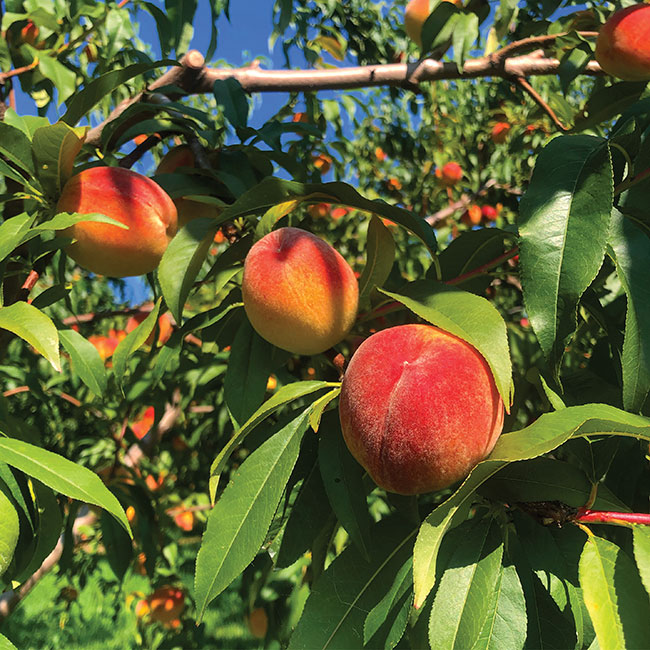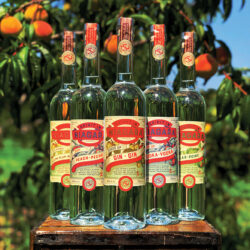
Features
Profiles
Sustainability
Raising a glass to reducing food waste
Niagara tender fruit farmer Arnie Lepp couldn’t stomach throwing away tons of perfectly good peaches and plums – so he opened a distillery.
February 28, 2024 By J.P. Antonacci
 Every year, more than 3,000 tons of imperfect or overripe peaches, plums and other tender fruit grown in the Niagara region of Ontario are thrown away. All photos courtesy of Spirit in Niagara.
Every year, more than 3,000 tons of imperfect or overripe peaches, plums and other tender fruit grown in the Niagara region of Ontario are thrown away. All photos courtesy of Spirit in Niagara. Every year, more than 3,000 tons of peaches, plums and other tender fruit grown in Ontario’s Niagara region are thrown away for being overripe or not pretty enough for grocery store shelves.
Arnie Lepp thinks that’s a sin.
In search of a way to reduce food waste in the region, the fourth-generation tender fruit and grape farmer hit upon the idea of turning those bruised and discoloured apricots, pears and cherries into alcohol.
Spirit in Niagara Distillery (SiN for short) opened in Niagara-in-the-Lake in 2021, and today boasts a line of vodka, gin and eau de vie made from tasty tender fruit that would have otherwise ended up composted or rotting in a field. “Whatever has a mark, whatever’s overripe – all that kind of fruit that normally would get dumped, we use it,” Lepp says. “Way too much fruit has gone to waste in Niagara. It’s a sin. That’s why we’re called Spirit in Niagara.”
Not only does the distillery use all the waste fruit from Lepp’s 200-acre farm, he also buys imperfect plums and cherries from neighbouring farms, turning a waste product into an income stream and saving even more food – about 400 tons of fresh fruit annually – from landfill.
“It’s significant. It’s quite a bit of fruit,” says Lepp, who attributes his waste-not mentality to his Mennonite upbringing.
Faced with mountains of wasted fruit, opening a distillery “seemed like a natural fit” with Lepp’s farm and his tender fruit shipping business – the largest family-run operation in the province – which provided easy access to fresh fruit from other growers.
“It seemed like a really good idea. Why hadn’t anybody done it before?” Lepp recalls wondering. He soon learned it was because the upfront cost to open a distillery is significant.
“It’s pretty expensive to make alcohol out of fruit. It’s probably four times what it would cost to make it out of grain,” Lepp explains. “Despite the sweetness of the fruit, it does not yield a lot of alcohol.”
But what is yielded is unique, he says.

Arnie Lepp, fourth-generation tender fruit and grape farmer in Niagara-on-the-Lake, Ont.
Fruit that has fallen on the orchard floor or been bruised in transit is often the juiciest and sweetest, even as grocery stores reject it. At Spirit in Niagara, the fruit is not juiced but run through a pitting machine and turned into mash that is then fermented and distilled. “So it retains all the flavour, instead of what you might get out of the juice. All the skins, all the pulp – all the flavour is left,” Lepp says.
The stillage, which is any organic matter remaining after the distilling process, “goes right back into the orchard where the peaches were harvested,” Lepp adds. “So it’s a 100 per cent full-circle process.”
Spirit in Niagara has carved out a market niche as a local producer of fruit-based spirits in a market currently dominated by imports.
“It’s been driven by the whole cocktail craze that’s going on right now,” Lepp says.
The spirits are not artificially flavoured, meaning the vodka and gin have a neutral taste while the eau de vie retains the flavour of its source fruit. “People are surprised by what flavours they bring to the table,” Lepp says, adding that all the spirits have “totally different viscosity and mouth feel than grain alcohols.”
Master distiller Joshua Beach also makes whiskeys and bourbons for Spirit in Niagara, while any vinifera and seedless grapes – which account for about half the acreage on Lepp’s farm – with insufficient sugar content to make wine go into the still to make vermouth and grappa.
To Lepp, the “most rewarding product” is a recent addition called the “plumincello” – a “fruit-forward” limoncello-like digestif made from Niagara sour yellow plums.
Spirit in Niagara has won international awards for its gin and vodka, which were a shot in the arm for the nascent distillery. Receiving an award of merit from the Niagara Peninsula Conservation Authority due to the distillery’s waste-reduction practices was “so encouraging,” Lepp says.
In addition to upcycling the waste fruit, the distillery uses no refrigeration equipment, instead using a geothermal system to cool water in “huge underground tanks” that are kept at a constant 55 degrees, Lepp says. Nutrient-rich wastewater flows from the stillage tank to feed a nearby wetland, using no chemicals or energy-sucking pumps to irrigate the orchards with “green manure” and “give the fruit back to the fields” in what Lepp describes as “an all-natural process.”
More and more growers are focused on reducing food waste, says Alexandra Grygorczyk, a research scientist at Vineland Research and Innovation Centre in Vineland, Ont. Within the last five years, Grygorczyk says, processors, retailers and governments have also come to realize the environmental and economic benefits of finding new uses for fruits, vegetables and spent grains, among other foodstuffs. “There’s much more attention being paid to it, for sure,” she says. “Now it seems there’s new companies popping up all the time to upcycle food.”
There is no shortage of food to upcycle, as the United Nations Food and Agriculture Organization estimates roughly one-third of food produced for human consumption is wasted, including half of all produce – nearly six million metric tonnes of fruits and vegetables per year – globally. Most of that waste is generated before the food gets to the consumer, meaning more work is needed to divert food waste on the farm and during processing.
Throwing away food means squandering the nutrient, fuel and labour inputs that went into growing it, Grygorczyk notes. “If you can find an avenue to sell those byproducts, you make a farm much more efficient and much more profitable.”
Finding a buyer is the trick in Niagara, which lacks a central hub for processing waste fruit. “One of the challenges of the peach industry is it’s very scattered. So you don’t have a large producer or packer that has huge volumes available,” Grygorczyk says. “In Niagara, you have 50 or so packers, and you might be able to collect a ton or half a ton per location.” Individual farms often cannot afford the significant upfront capital costs of processing themselves and would rather sell the raw material to a processor, Grygorczyk explains. But processors do not want to spend the fuel and time required to gather the needed volume of fruit.
With the closure of canneries removing a major market for discarded fruit, and in the absence of a centralized database to track rejected produce, processors must now depend on personal connections and ad hoc arrangements with farmers.
“Ultimately what that means for the peach industry is the individual growers have to come up with their own homegrown solutions, because it’s difficult for a larger company to come in and buy all the seconds,” Grygorczyk says.

Spirit in Niagara Distillery uses all the waste fruit from Lepp’s 200-acre farm and imperfect plums and cherries from neighbouring farms, diverting the fruit from landfills.
Some waste food is sold to livestock farms or pet food companies, or added to fields as nutrients. Grygorczyk says the ideal outcome is to keep discarded produce in the human food chain and out of anaerobic landfills, where piles of oxygen-starved rotting food generate greenhouse gases – namely methane – that play a significant role in climate change. “Organic matter breaking down in landfills is one of the important contributors to our greenhouse gas emissions as a country,” she says.
Some farmers in Niagara juice their rejected tender fruit, which Lepp says is simpler and possibly more profitable than his admittedly multifaceted solution to the food waste problem. But much of the rejected crop ends up piled in landfills or on marginal farmland, attracting insects like spotted wing drosophila.
“You can’t put it back in the orchard, because it’ll rot next year’s drop,” Lepp says. “By removing that (fruit) from the field, we’re controlling other problems that affect the fruit industry.”
Two years in, Spirit in Niagara hosts a busy slate of distillery tours, tasting and special events, with a staff of 15 employees busy in the storefront, restaurant and bottling shop.
Locally made spirits are available at retail locations in the Niagara area and online via the LCBO, Ontario’s liquor retailer, and Lepp is optimistic their market share will continue to grow as more consumers become aware that rejected fruit can be turned into high-end spirits.
There is “absolutely” a payoff for the distillery in terms of lower hydro bills, Lepp says. But getting rich is not the point. Lepp calls it a “privilege” to prevent perfectly good fruit from being wasted and do his part to address global warming by cutting emissions. “I believe it is important – just to save the waste and recycle everything back to the earth,” he says. “That was the only motivation.” •
Print this page